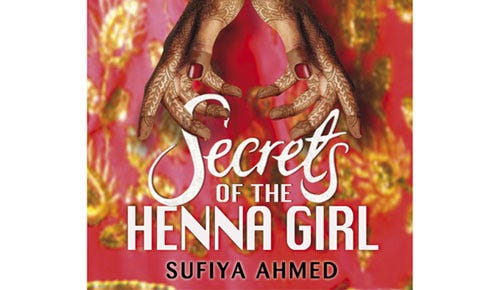A product has been added to the basket
Secrets of the Henna Girl: an Interview with Sufiya Ahmed

Secrets of the Henna Girl: an Interview with Sufiya Ahmed
To kick start our series of writing inspiration blog posts we’ve decided to shine a spotlight on the wonderful world of writing for children.
Fiction for children and young adults is one of the most fascinating genres in the literary world, comprising poetry, short stories and novels which have been written primarily for the enjoyment of readers whose ages range anywhere from 3 to 18. However, many stories which were written for children have since passed into literary canon as classics which have been enjoyed by young and old alike: Lewis Carroll’s Alice in Wonderland and J.K Rowling’s Harry Potter series are two such examples.

 Hi Sufiya. How are you today?
Hi, I’m well thanks. Busy with school visits to talk about Secrets of the Henna Girl – something I love to do.
What is it that attracted you to writing children’s fiction?
I always wanted to write for children . It was my own childhood dream and I was really inspired by my two favourite authors Roald Dahl and Enid Blyton.
Secrets of a Henna Girl has received a lot of attention. Why do you think this book has resonated so clearly with its audiences?
Ooh I think that’s a question for the readers. No seriously, I think readers are intrigued by the heroine’s story and her courage. She finds herself in a horrible situation and the story is really about how she tries to get herself out of it. It’s about her courage..
How would you describe the difference between writing for children, for young adults, and for adults?
I think when you write for young adults and children, you can hint at suffering rather than lay out graphic scenes. I think you can trust the young reader to use their own imagination up to the point they feel comfortable with. Life is hard for a couple of the supporting characters in Secrets of the Henna Girl and they endured real suffering, but all of this is revealed through dialogue.
For adults, it’s different. You don’t have to worry about the boundaries of what is age appropriate.
What challenges did you face when trying to communicate the complex issues addressed in Secrets of a Henna Girl to a younger audience?
Forced marriage is a complex issue and every victim will have a different story to tell. Different emotions, different levels of guilt, rebellion, fear and courage. I wanted to tell a simple story which begins with the heroine as a victim but is really a story of hope.
What’s your writing process like?
I begin by carrying a story in my head for a long time. I’ll mull over the plot and characters and think long and hard about how my heroine will overcome. There’s no set time for how long it will take me to finish a story. I love the first draft stage and can write for hours. But I have to apply discipline when it’s time to go over the edits. I like to use pens when I write, as my imagination gets blocked when using the keypad .When I finish I’ll celebrate by reading another author’s book. Reading relaxes me.
Are you looking forward to the Sheffield Children’s Book Awards? How do you feel about the other shortlisted authors?
I’m really looking forward to the Book Awards and feel very honoured to be on the shortlist with some great authors.
Thanks Sufiya! You can find out more about Sufiya Ahmed and Secrets of a Henna Girl by visiting her blog: sufiyaahmed.blogspot.co.uk. The Sheffield Children’s Book Awards, for which her novel is shortlisted as a finalist, will be held on the 28th of November 2013.
Hi Sufiya. How are you today?
Hi, I’m well thanks. Busy with school visits to talk about Secrets of the Henna Girl – something I love to do.
What is it that attracted you to writing children’s fiction?
I always wanted to write for children . It was my own childhood dream and I was really inspired by my two favourite authors Roald Dahl and Enid Blyton.
Secrets of a Henna Girl has received a lot of attention. Why do you think this book has resonated so clearly with its audiences?
Ooh I think that’s a question for the readers. No seriously, I think readers are intrigued by the heroine’s story and her courage. She finds herself in a horrible situation and the story is really about how she tries to get herself out of it. It’s about her courage..
How would you describe the difference between writing for children, for young adults, and for adults?
I think when you write for young adults and children, you can hint at suffering rather than lay out graphic scenes. I think you can trust the young reader to use their own imagination up to the point they feel comfortable with. Life is hard for a couple of the supporting characters in Secrets of the Henna Girl and they endured real suffering, but all of this is revealed through dialogue.
For adults, it’s different. You don’t have to worry about the boundaries of what is age appropriate.
What challenges did you face when trying to communicate the complex issues addressed in Secrets of a Henna Girl to a younger audience?
Forced marriage is a complex issue and every victim will have a different story to tell. Different emotions, different levels of guilt, rebellion, fear and courage. I wanted to tell a simple story which begins with the heroine as a victim but is really a story of hope.
What’s your writing process like?
I begin by carrying a story in my head for a long time. I’ll mull over the plot and characters and think long and hard about how my heroine will overcome. There’s no set time for how long it will take me to finish a story. I love the first draft stage and can write for hours. But I have to apply discipline when it’s time to go over the edits. I like to use pens when I write, as my imagination gets blocked when using the keypad .When I finish I’ll celebrate by reading another author’s book. Reading relaxes me.
Are you looking forward to the Sheffield Children’s Book Awards? How do you feel about the other shortlisted authors?
I’m really looking forward to the Book Awards and feel very honoured to be on the shortlist with some great authors.
Thanks Sufiya! You can find out more about Sufiya Ahmed and Secrets of a Henna Girl by visiting her blog: sufiyaahmed.blogspot.co.uk. The Sheffield Children’s Book Awards, for which her novel is shortlisted as a finalist, will be held on the 28th of November 2013.

History
There didn’t used to be any such genre as children’s fiction. However, in the mid-19th century, the combination of improving literacy rates and a relaxation of the previously stringent emphasis on children only having access to informative texts, resulted in a new demand for entertaining literature aimed at a younger audience. With the publication of Alice in Wonderland in 1865, a new tradition of children’s fiction became established, which rose in popularity throughout the 19th and 20th centuries.A Unique Style
Children appreciate literature in a very different way to adults and they are universally recognised as being one of the most difficult audiences to impress. Therefore, many children’s fiction authors will often spend considerable amounts of time with children, learning about their reading habits and re-acquainting themselves with the unique processes of childhood imagination, before sitting down to write. However, it’s important to remember that the process of writing children’s fiction shares many similarities with that of writing for older audiences. Authors should always take care to:- Know their audience
- Brainstorm ideas
- Develop their characters
- Develop a clear plot with strong motifs
- Edit carefully and thoroughly
Writing Inspiration from Sufiya Ahmed
If you’re thinking about writing children’s fiction, it’s important to take inspiration from authors who’ve gone before. So to help us today we’ve asked renowned children’s fiction author and BIBA founder Sufiya Ahmed, whose book Secrets of the Henna Girl has earned her a Redbridge Children’s Book Award and a shortlisted place for the upcoming Sheffield Children’s Book Award, to shed some light on her own writing process. Hi Sufiya. How are you today?
Hi, I’m well thanks. Busy with school visits to talk about Secrets of the Henna Girl – something I love to do.
What is it that attracted you to writing children’s fiction?
I always wanted to write for children . It was my own childhood dream and I was really inspired by my two favourite authors Roald Dahl and Enid Blyton.
Secrets of a Henna Girl has received a lot of attention. Why do you think this book has resonated so clearly with its audiences?
Ooh I think that’s a question for the readers. No seriously, I think readers are intrigued by the heroine’s story and her courage. She finds herself in a horrible situation and the story is really about how she tries to get herself out of it. It’s about her courage..
How would you describe the difference between writing for children, for young adults, and for adults?
I think when you write for young adults and children, you can hint at suffering rather than lay out graphic scenes. I think you can trust the young reader to use their own imagination up to the point they feel comfortable with. Life is hard for a couple of the supporting characters in Secrets of the Henna Girl and they endured real suffering, but all of this is revealed through dialogue.
For adults, it’s different. You don’t have to worry about the boundaries of what is age appropriate.
What challenges did you face when trying to communicate the complex issues addressed in Secrets of a Henna Girl to a younger audience?
Forced marriage is a complex issue and every victim will have a different story to tell. Different emotions, different levels of guilt, rebellion, fear and courage. I wanted to tell a simple story which begins with the heroine as a victim but is really a story of hope.
What’s your writing process like?
I begin by carrying a story in my head for a long time. I’ll mull over the plot and characters and think long and hard about how my heroine will overcome. There’s no set time for how long it will take me to finish a story. I love the first draft stage and can write for hours. But I have to apply discipline when it’s time to go over the edits. I like to use pens when I write, as my imagination gets blocked when using the keypad .When I finish I’ll celebrate by reading another author’s book. Reading relaxes me.
Are you looking forward to the Sheffield Children’s Book Awards? How do you feel about the other shortlisted authors?
I’m really looking forward to the Book Awards and feel very honoured to be on the shortlist with some great authors.
Thanks Sufiya! You can find out more about Sufiya Ahmed and Secrets of a Henna Girl by visiting her blog: sufiyaahmed.blogspot.co.uk. The Sheffield Children’s Book Awards, for which her novel is shortlisted as a finalist, will be held on the 28th of November 2013.
Hi Sufiya. How are you today?
Hi, I’m well thanks. Busy with school visits to talk about Secrets of the Henna Girl – something I love to do.
What is it that attracted you to writing children’s fiction?
I always wanted to write for children . It was my own childhood dream and I was really inspired by my two favourite authors Roald Dahl and Enid Blyton.
Secrets of a Henna Girl has received a lot of attention. Why do you think this book has resonated so clearly with its audiences?
Ooh I think that’s a question for the readers. No seriously, I think readers are intrigued by the heroine’s story and her courage. She finds herself in a horrible situation and the story is really about how she tries to get herself out of it. It’s about her courage..
How would you describe the difference between writing for children, for young adults, and for adults?
I think when you write for young adults and children, you can hint at suffering rather than lay out graphic scenes. I think you can trust the young reader to use their own imagination up to the point they feel comfortable with. Life is hard for a couple of the supporting characters in Secrets of the Henna Girl and they endured real suffering, but all of this is revealed through dialogue.
For adults, it’s different. You don’t have to worry about the boundaries of what is age appropriate.
What challenges did you face when trying to communicate the complex issues addressed in Secrets of a Henna Girl to a younger audience?
Forced marriage is a complex issue and every victim will have a different story to tell. Different emotions, different levels of guilt, rebellion, fear and courage. I wanted to tell a simple story which begins with the heroine as a victim but is really a story of hope.
What’s your writing process like?
I begin by carrying a story in my head for a long time. I’ll mull over the plot and characters and think long and hard about how my heroine will overcome. There’s no set time for how long it will take me to finish a story. I love the first draft stage and can write for hours. But I have to apply discipline when it’s time to go over the edits. I like to use pens when I write, as my imagination gets blocked when using the keypad .When I finish I’ll celebrate by reading another author’s book. Reading relaxes me.
Are you looking forward to the Sheffield Children’s Book Awards? How do you feel about the other shortlisted authors?
I’m really looking forward to the Book Awards and feel very honoured to be on the shortlist with some great authors.
Thanks Sufiya! You can find out more about Sufiya Ahmed and Secrets of a Henna Girl by visiting her blog: sufiyaahmed.blogspot.co.uk. The Sheffield Children’s Book Awards, for which her novel is shortlisted as a finalist, will be held on the 28th of November 2013.










Comments